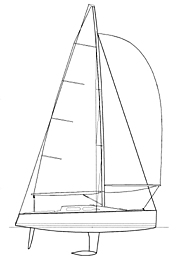Sea Quest 36
Racer
Reichel/Pugh has been responsible for some exciting fast racing yachts recently, including Roy Disney's Pyewacket and the 86-foot Zephrus. They also did the Team Dennis Connor America's Cup boats. Add to these a slug of line honors-type big and exotic boats like Shockwave. Clearly they work in rarified but pleasant air. This new 36-footer built in the UK by Seaquest yachts brings R/P down to earth somewhat. The 36 is primarily a racing yacht but it has interior features that could make it a comfortable cruising boat if your cruising preferences lean toward the light and the quick.
This hull shows a tight turn at the bilge and a pronounced flat bottom that fairs out toward the transom. By the time you get to the transom the sectional shape is almost round. The topsides are very flat with almost no convexity to them at all. The angle of entry for this fine bowed yacht is 17 degrees. If you mentally heel this shape over 20 degrees it creates a very symmetrical shape with a narrow heeled BWL. It looks to my eye like the LCB is quite far aft on this.
The D/L is 124, making the 36 light, but not ultra light. The ballast/displacement ratio is 46 percent and that should ensure good stability with the 7-foot, 2-inch draft bulb keel. This flattened bottom, bulb fin combo is what we call an L-shape keel with the bulb hung off the leading edge of the fin. This shape eliminates the need for a complex kelp cutter, although kelp can still stick to that vertical leading edge. The drawback to the L keel is that there is quite a twisting moment on the fin imposed by having the CG of the bulb aft of the center of the fin. To take this load the fin is cast iron while the bulb is lead. The sheerline is a straight line but this works well with the relatively high freeboard and the short ends. R/P was kind and confident enough to provide me with a set of lines for this boat.
The interior is far more than what you would find on an all out racing boat. There are double quarterberths and if I'm reading the drawings correctly you can shut these quarterberth areas off with a door. That would make for some tight and difficult to ventilate sleeping areas. I'd prefer to leave these berths open to the saloon and forget about privacy. The galley is small but adequate and the nav station is generous. The V-berths look skimpy to me but they would be fine for kids. The interior is a molded liner type.
The tall fractional rig has spreaders swept 18 degrees and two spreaders. There are no runners. The sailplan indicates pre-bend to the mast. The mainsail leech barely overlaps the backstay. It's very interesting that this 36-footer has about the same rig size as the 40-foot Najad. The difference is the 17,000-pound difference in displacement. Think of SA/D as horsepower-per-pound. The SA/D of the Seaquest is 26. You will be able to sail this boat aggressively and efficiently in light air. The other edge of the sword is that you will have to reef early if you want to keep the Seaquest on its feet. Having said that I think many cruisers would be surprised at the stiffness of this high ballast-to-displacement yacht. But for racing there is simply no substitute for sail area, unless it's a gift rating.
The Seaquest 36 is a nice break from the boring dual-purpose boats that I have been swamped with lately. Many of us daysail our boats and take occasional cruises and once and a while we enter a local race. I'll go out on a limb here and say it's a lot more fun to cruise a racing boat than it is to race a cruising boat.

Comments